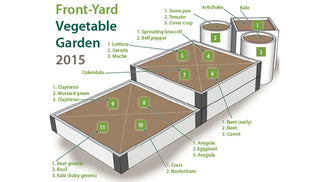 The garden in 2014, a few days after planting.
The garden in 2014, a few days after planting.In 2014, we planted a vegetable garden in the "front yard" of our administrative office in Burlington, VT. Based on a successful first season, we think it's a tradition that will carry on for a long time.
This year, we hope to try a wider variety of crops and make a more concerted effort with second (and third) plantings as mature crops are harvested. You can see our plan, below, which shows half of the planting. The other side will be exactly the same.

The beds were cover-cropped with rye in the fall, so our only chore in spring is amending the soil with the Raised Bed Booster Kit and turning in the cover crop. The first crops — including peas, artichokes, kale and cress — will be planted in late March. By mid-May, we'll have the Snip-n-Drip watering system in place.

The first seed we plant is artichoke — about mid-February. To grow these successfully in the north, we need to plant early and "vernalize" them before planting them in their permanent locations. To vernalize, you expose the seedlings to cold weather but keep them protected from frost. It's kind of an extended version of hardening off. Because the seedlings are in pots for such a long time, we start them in Rootrainers, which are about 5" deep, allowing for lots of root growth. The seedling above was just "potted up" into a Cowpot, where it will grow until it's time to vernalize and plant in the garden.
To ensure that our garden looks sharp for the whole season, we're starting many things indoors, from seed. That way, we'll have sturdy-looking seedlings to plant. Some crops — such as carrots — will be direct-sown because they don't benefit from a headstart indoors.
Our detailed planting plan is shown below, with succession crops and all. We looked at each planting zone as having three seasons: spring, summer and fall. In some zones, the same plant will be grown all season, but there are many with several crops. For instance, zone 5 will start the season with lettuce. Once that's harvested in June, we'll plant carrots, which will be ready for harvest in August. To finish the season, we'll replant with mache (lamb's lettuce), which thrives in cooler weather. Although we divided our beds into triangles, we used square-foot gardening techniques to guide us.
Gardening is unpredictable, so we expect to have a crop or two that fails. If so, we'll adjust and plant something else. Failures are part of the fun.
|
Spot
|
Early
|
Mid
|
Late
|
|
|---|---|---|---|---|
|
1
|
Tavor artichoke
|
Tavor artichoke
|
Cover crop,
to be determined |
|
|
2
|
Dwarf Grey Sugar
snow pea |
Glacier tomato
|
Cover crop,
to be determined |
|
|
3
|
Vates kale
|
|||
|
4
|
Hon Tsai Thai sprouting broccoli
|
Purple Beauty pepper
|
Purple Beauty pepper
|
|
|
5
|
Lettuce: Rhazes Romaine and Winter Density
|
Yellowstone carrot
|
Vit mache
|
|
|
6
|
Early Wonder Tall Top beet
|
Touchstone Gold beet
|
Miami carrot
|
|
|
7
|
Pacific Beauty calendula
|
|||
|
8
|
Astro arugula
|
Little Finger eggplant
|
Astro arugula
|
|
|
9
|
Claytonia
|
Garnet Giant |
Claytonia
|
|
|
10
|
Crinkled, Wrinkled, Crumpled cress
|
Nasturtium
|
Nasturtium
|
|
|
11
|
Bull's Blood beet greens |
Sweet Thai basil
|
Vates kale
(for baby greens) |
|





